Impact of Partial Replacement of Cement with a Blend of Marble and Granite Waste Powder on Mortar
Abstract
:1. Introduction
2. Materials and Methods
2.1. Materials
2.1.1. Cement
2.1.2. Marble and Granite Waste Powder
2.1.3. Fine Aggregate
2.2. Mortar Mix Preparation
2.3. Characterization of MGWP
2.3.1. Fourier Transform Infrared (FTIR) Analysis
2.3.2. Thermogravimetric Analysis (TGA)
2.4. Test Methods for Mortar
| Test Category | Properties | Test Standards | Examined Samples | Curing Ages |
|---|---|---|---|---|
| Fresh | Workability | ASTM C1437 | All | – |
| Hardened | Water absorption | ASTM C642 [31] | All | 3, 7, 28, 56, 90 days |
| Compression strength | ASTM C109 [34] | |||
| Homogeneity | ASTM C597 [33] | |||
| Sulfate attack resistance | ASTM C1012/C1012M [35] | |||
| Bulk density | ASTM C29/C29M [25] | |||
| Microstructure | Thermal decomposition | – | MGWP-0, MGWP-10, MGWP-30 | 28 days |
| Mineralogical composition | – | 7 and 28 days |
3. Results and Discussion
3.1. Effects of MGWP on Workability
3.2. Effects of MGWP on Physical and Mechanical Properties of Mortar
3.2.1. Bulk Density
3.2.2. Compressive Strength
3.2.3. Homogeneity
3.3. Effects of MGWP on Durability Properties of Mortar
3.3.1. Sulfate Attack Resistance
3.3.2. Water Absorption and Porosity
3.4. Effects of MGWP on Microstructure Properties of Mortar
3.4.1. Scanning Electron Microscopy
3.4.2. Fourier Transform Infrared
3.4.3. Thermogravimetric Analysis
3.4.4. Differential Thermal Analysis
4. Conclusions
- As per the ASTM C618 standard, GWP can be categorized as a Class N natural pozzolan material, which signifies its pozzolanic properties. However, MWP does not meet the requirements to be classified as a pozzolan material according to the same ASTM standard.
- As the percentage of MGWP increased, the workability of the mortar mixes decreased, which can be attributed to the higher fineness of the MGWP particles.
- The addition of up to 15% MGWP led to an improvement in the bulk density, compressive strength, and homogeneity of the mortar, with the mortar containing 10% MGWP showing the best performance in these tests. Similar improvements were also observed in properties related to durability, specifically resistance to sulfate attack, water absorption, and porosity.
- A microstructure analysis confirmed that the addition of MGWP resulted in changes in the structure of C–S–H gels in the mortar samples. The morphological structure of the mixes became denser up to a 10% content of MGWP. However, a slight increase in mass loss was observed with an increase in MGWP content when exposed to high temperatures.
- Replacing up to 10% of cement with MGWP in mortar can improve its physical, mechanical, and durability properties. Incorporating the MGWP, which would otherwise be landfilled, in the mortar allows for a reduction in the usage of OPC. This reduction could contribute to achieving sustainability in the concrete industry.
Author Contributions
Funding
Informed Consent Statement
Data Availability Statement
Conflicts of Interest
References
- Rubenstein, M. Emissions from the Cement Industry. Available online: https://news.climate.columbia.edu/2012/05/09/emissions-from-the-cement-industry/ (accessed on 20 June 2023).
- Preston, F.; Lehne, J.; Making Concrete Change Innovation in Low-carbon Cement and Concrete. Chatham House Report. 2018. Available online: https://www.chathamhouse.org/2018/06/making-concrete-change-innovation-low-carbon-cement-and-concrete (accessed on 20 June 2023).
- Endale, S.A.; Taffese, W.Z.; Vo, D.-H.; Yehualaw, M.D. Rice Husk Ash in Concrete. Sustainability 2022, 15, 137. [Google Scholar] [CrossRef]
- Gedefaw, A.; Worku Yifru, B.; Endale, S.A.; Habtegebreal, B.T.; Yehualaw, M.D. Experimental Investigation on the Effects of Coffee Husk Ash as Partial Replacement of Cement on Concrete Properties. Adv. Mater. Sci. Eng. 2022, 2022, 1–10. [Google Scholar] [CrossRef]
- Yehualaw, M.D.; Alemu, M.; Hailemariam, B.Z.; Vo, D.-H.; Taffese, W.Z. Aquatic Weed for Concrete Sustainability. Sustainability 2022, 14, 15501. [Google Scholar] [CrossRef]
- Zerihun, B.; Yehualaw, M.D.; Vo, D.-H. Effect of Agricultural Crop Wastes as Partial Replacement of Cement in Concrete Production. Adv. Civ. Eng. 2022, 2022, 1–31. [Google Scholar] [CrossRef]
- Worku, M.A.; Taffese, W.Z.; Hailemariam, B.Z.; Yehualaw, M.D. Cow Dung Ash in Mortar: An Experimental Study. Appl. Sci. 2023, 13, 6218. [Google Scholar] [CrossRef]
- Pappu, A.; Thakur, V.K.; Patidar, R.; Asolekar, S.R.; Saxena, M. Recycling Marble Wastes and Jarosite Wastes into Sustainable Hybrid Composite Materials and Validation through Response Surface Methodology. J. Clean. Prod. 2019, 240, 118249. [Google Scholar] [CrossRef]
- Aliabdo, A.A.; Abd Elmoaty, A.E.M.; Auda, E.M. Re-Use of Waste Marble Dust in the Production of Cement and Concrete. Constr. Build. Mater. 2014, 50, 28–41. [Google Scholar] [CrossRef]
- Yifru, B.W.; Mitikie, B.B. Partial Replacement of Sand with Marble Waste and Scoria for Normal Strength Concrete Production. SN Appl. Sci. 2020, 2, 1938. [Google Scholar] [CrossRef]
- Amin, S.K.; Allam, M.E.; Garas, G.L.; Ezz, H. A study of the chemical effect of marble and granite slurry on green mortar compressive strength. Bull. Natl. Res. Cent. 2020, 44, 19. [Google Scholar] [CrossRef] [Green Version]
- Ghorbani, S.; Ghorbani, S.; Elmi, A.; Soleimani, V.; Taji, I.; Mohammadi-Khatami, M.; Tavakkolizadeh, M.; de Brito, J. Simultaneous Effect of Granite Waste Dust as Partial Replacement of Cement and Magnetized Water on the Properties of Concrete Exposed to NaCl and H2SO4 Solutions. Constr. Build. Mater. 2021, 288, 123064. [Google Scholar] [CrossRef]
- Asadi Shamsabadi, E.; Ghalehnovi, M.; de Brito, J.; Khodabakhshian, A. Performance of Concrete with Waste Granite Powder: The Effect of Superplasticizers. Appl. Sci. 2018, 8, 1808. [Google Scholar] [CrossRef] [Green Version]
- Kumar, Y.Y.; Vardhan, C.M.V.; Anitham, A. Use of Granite Waste as Partial Substitute to Cement in Concrete. Int. J. Eng. Res. Appl. 2015, 5, 25–31. [Google Scholar]
- Prokopski, G.; Marchuk, V.; Huts, A. The Effect of Using Granite Dust as a Component of Concrete Mixture. Case Stud. Constr. Mater. 2020, 13, e00349. [Google Scholar] [CrossRef]
- Lezzerini, M.; Luti, L.; Aquino, A.; Gallello, G.; Pagnotta, S. Effect of Marble Waste Powder as a Binder Replacement on the Mechanical Resistance of Cement Mortars. Appl. Sci. 2022, 12, 4481. [Google Scholar] [CrossRef]
- ES 1177-1 and 2; Composition, Specifications and Conformity Criteria for Common Cements and Conformity Evaluation. Ethiopian Standards Agency: Addis Ababa, Ethiopia, 2005.
- EN 197-1; Cement-Part 1: Composition, Specifications and Conformity Criteria for Common Cements. CEN: Brussels, Belgium, 2011.
- ASTM C618; A Standard Test Method for Coal Fly Ash and Raw Calcined Natural Pozzolan for Use in Concrete. American Society for Testing and Materials: West Conshohocken, PA, USA, 2015.
- Helmuth, R.; West, P.B. Reappraisal of the Autoclave Expansion Test. Cem. Concr. Aggreg. 1998, 20, 194–219. [Google Scholar]
- ASTM C136; Standard Test Method for Sieve Analysis of Fine and Coarse Aggregates. American Society for Testing and Materials: West Conshohocken, PA, USA, 2014.
- ASTM C33/C33M; Standard Specification for Concrete Aggregates. American Society for Testing and Materials: West Conshohocken, PA, USA, 2018.
- ASTM C128; Standard Test Method for Relative Density (Specific Gravity) and Absorption of Fine Aggregate. American Society for Testing and Materials: West Conshohocken, PA, USA, 2022.
- ASTM C566; Standard Test Method for Total Evaporable Moisture Content of Aggregate by Drying. American Society for Testing and Materials: West Conshohocken, PA, USA, 2019.
- ASTM C29/C29M; Standard Test Method for Bulk Density (“Unit Weight”) and Voids in Aggregate. American Society for Testing and Materials: West Conshohocken, PA, USA, 2019.
- Bukalo, N.N.; Ekosse, G.-I.E.; Odiyo, J.O.; Ogola, J.S. Fourier Transform Infrared Spectroscopy of Clay Size Fraction of Cretaceous-Tertiary Kaolins in the Douala Sub-Basin, Cameroon. Open Geosci. 2017, 9, 407–418. [Google Scholar] [CrossRef]
- Hughes, T.L.; Methven, C.M.; Jones, T.G.J.; Pelham, S.E.; Fletcher, P.; Hall, C. Determining Cement Composition by Fourier Transform Infrared Spectroscopy. Adv. Cem. Based Mater. 1995, 2, 91–104. [Google Scholar] [CrossRef]
- Horgnies, M.; Chen, J.J.; Bouillon, C. Overview about the Use of Fourier Transform Infrared Spectroscopy to Study Cementitious Materials. WIT Trans. Eng. Sci. 2013, 77, 251–262. [Google Scholar] [CrossRef] [Green Version]
- Menéndez, E.; Vega, L.; Andrade, C. Method to Evaluate the Residual Strength in Concrete Elements Exposed to Fire Using Physic-Chemical and Microstructural Parameters. In Concrete Repair, Rehabilitation and Retrofitting III.; Alexander, M.G., Beushausen, H.-D., Dehn, F., Moyo, P., Eds.; CRC Press: London, UK, 2012. [Google Scholar]
- ASTM C1437; Standard Test Method for Flow of Hydraulic Cement Mortar. Aggregates; American Society for Testing and Materials: West Conshohocken, PA, USA, 2020. [Google Scholar]
- ASTM C642; Standard Test Method for Density, Absorption, and Voids in Hardened Concrete. American Society for Testing and Materials: West Conshohocken, PA, USA, 2022.
- ASTM C109/C109M; Standard Test Method for Compressive Strength of Hydraulic Cement Mortars (Using 2-in. or [50-Mm] Cube Specimens). American Society for Testing and Materials: West Conshohocken, PA, USA, 2020.
- ASTM C597; Standard Test Method for Pulse Velocity Through Concrete. American Society for Testing and Materials: West Conshohocken, PA, USA, 2016.
- ASTM C109/C109M-20; Standard Test Method for Compressive Strength of Hydraulic Cement Mortars (Using 2-in. or [50-Mm] Cube Specimens). American Society for Testing and Materials: West Conshohocken, PA, USA, 2020.
- ASTM C1012/C1012M; Standard Test Method for Length Change of Hydraulic-Cement Mortars Exposed to a Sulfate Solution. American Society for Testing and Materials: West Conshohocken, PA, USA, 2019.
- IS 13311 (Part 1); Method of Non-Destructive Testing of Concrete, Part 1: Ultrasonic Pulse Velocity. Bureau of Indian Standards: New Delhi, India, 1992.
- Al-Dulaijan, S.U.; Maslehuddin, M.; Al-Zahrani, M.M.; Sharif, A.M.; Shameem, M.; Ibrahim, M. Sulfate Resistance of Plain and Blended Cements Exposed to Varying Concentrations of Sodium Sulfate. Cem Concr Compos 2003, 25, 429–437. [Google Scholar] [CrossRef]
- Zhang, S.P.; Zong, L. Evaluation of Relationship between Water Absorption and Durability of Concrete Materials. Adv. Mater. Sci. Eng. 2014, 2014, 1–8. [Google Scholar] [CrossRef] [Green Version]
- Pane, I.; Hansen, W. Investigation of Blended Cement Hydration by Isothermal Calorimetry and Thermal Analysis. Cem. Concr. Res. 2005, 35, 1155–1164. [Google Scholar] [CrossRef]
- Zhou, Z.; Sofi, M.; Lumantarna, E.; San Nicolas, R.; Hadi Kusuma, G.; Mendis, P. Strength Development and Thermogravimetric Investigation of High-Volume Fly Ash Binders. Materials 2019, 12, 3344. [Google Scholar] [CrossRef] [PubMed] [Green Version]
- Hager, I. Colour Change in Heated Concrete. Fire Technol. 2014, 50, 945–958. [Google Scholar] [CrossRef] [Green Version]


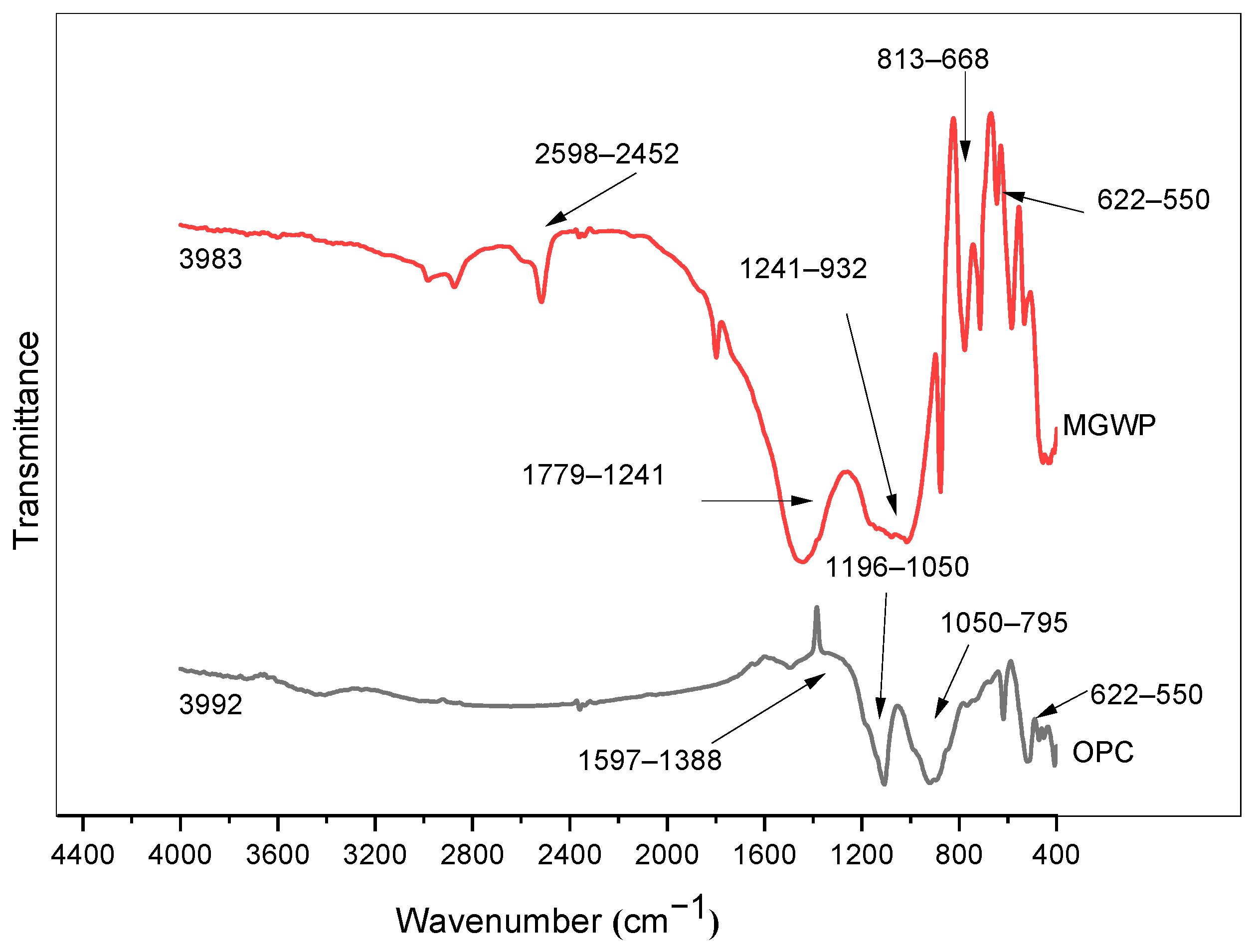
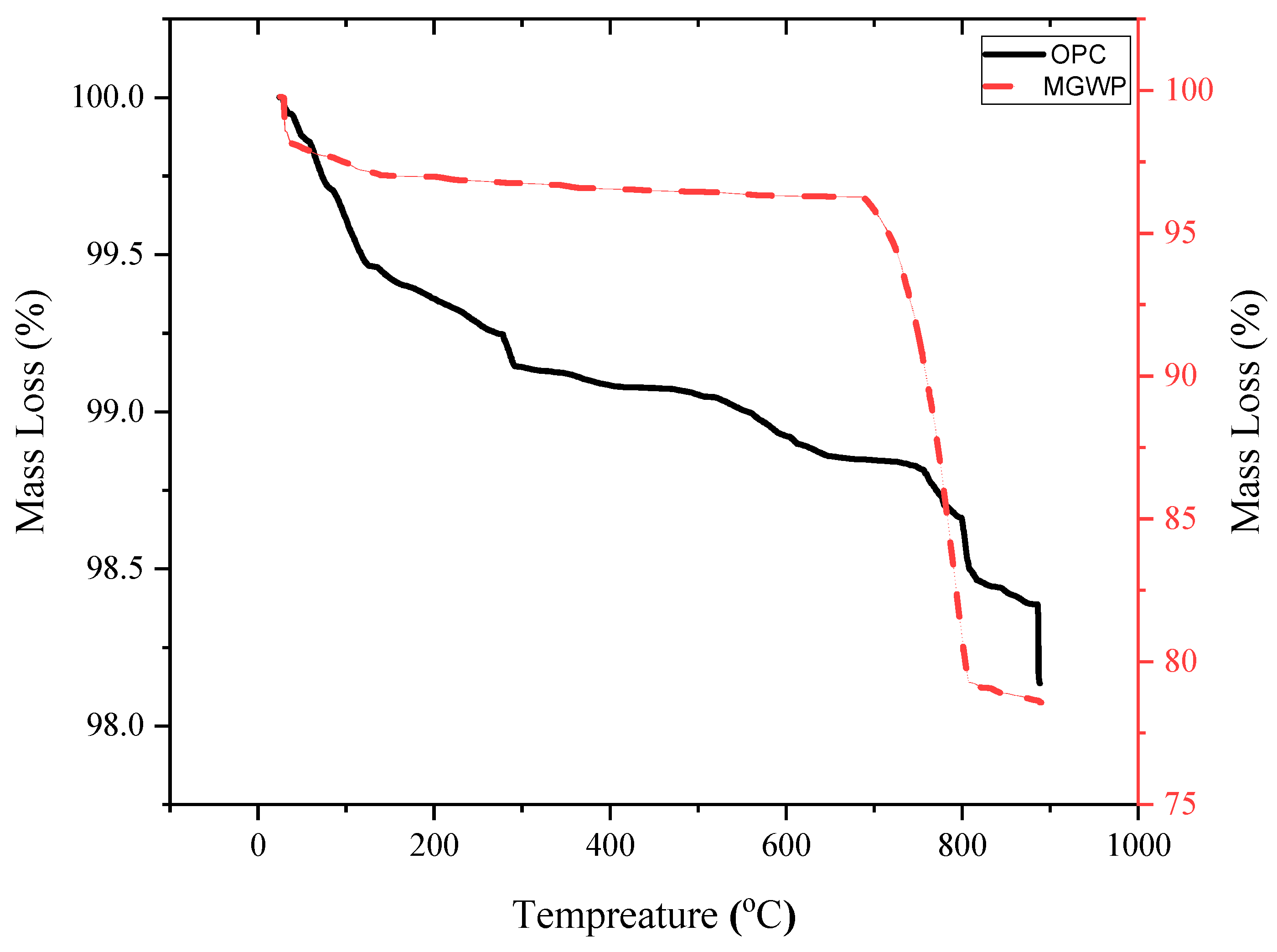
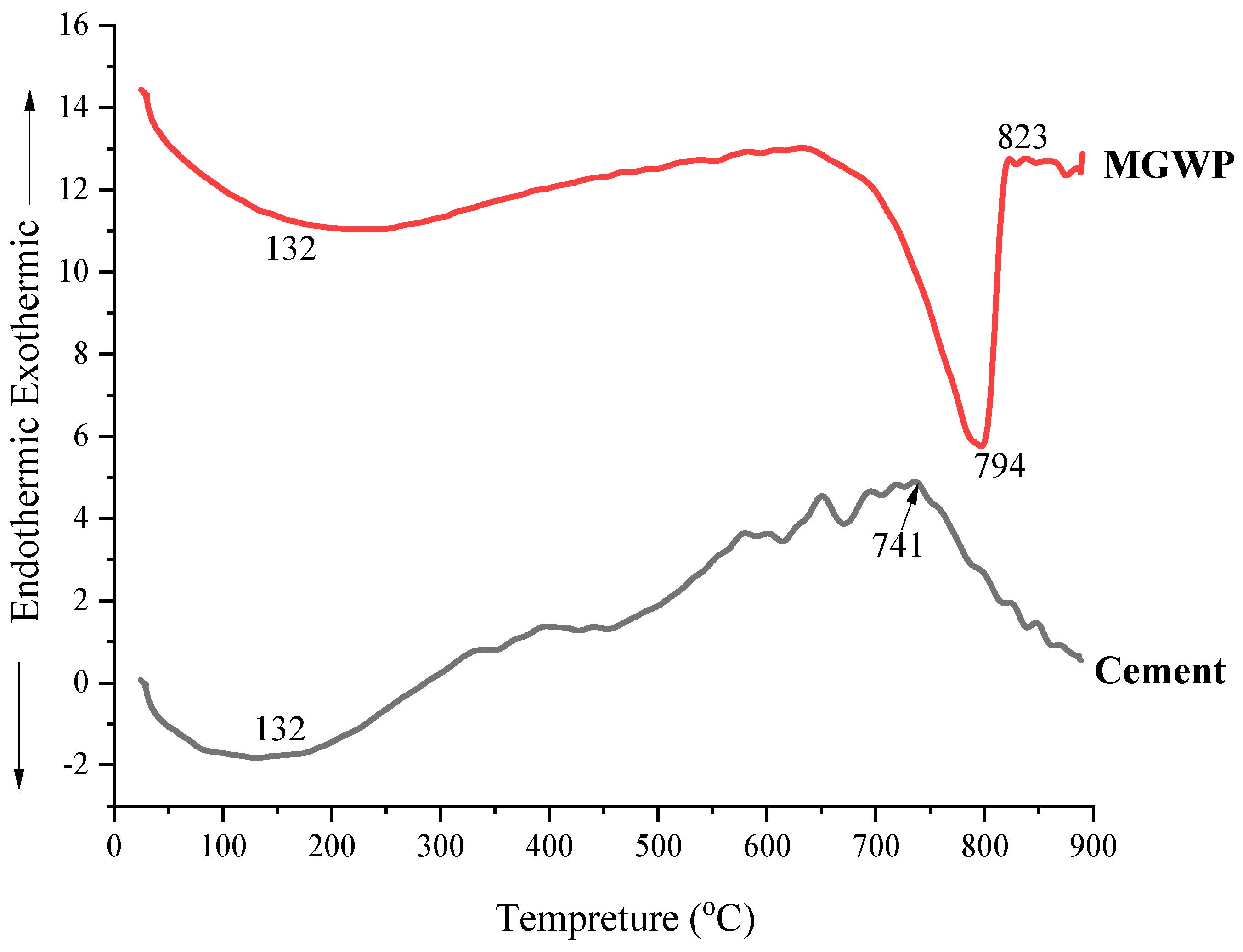
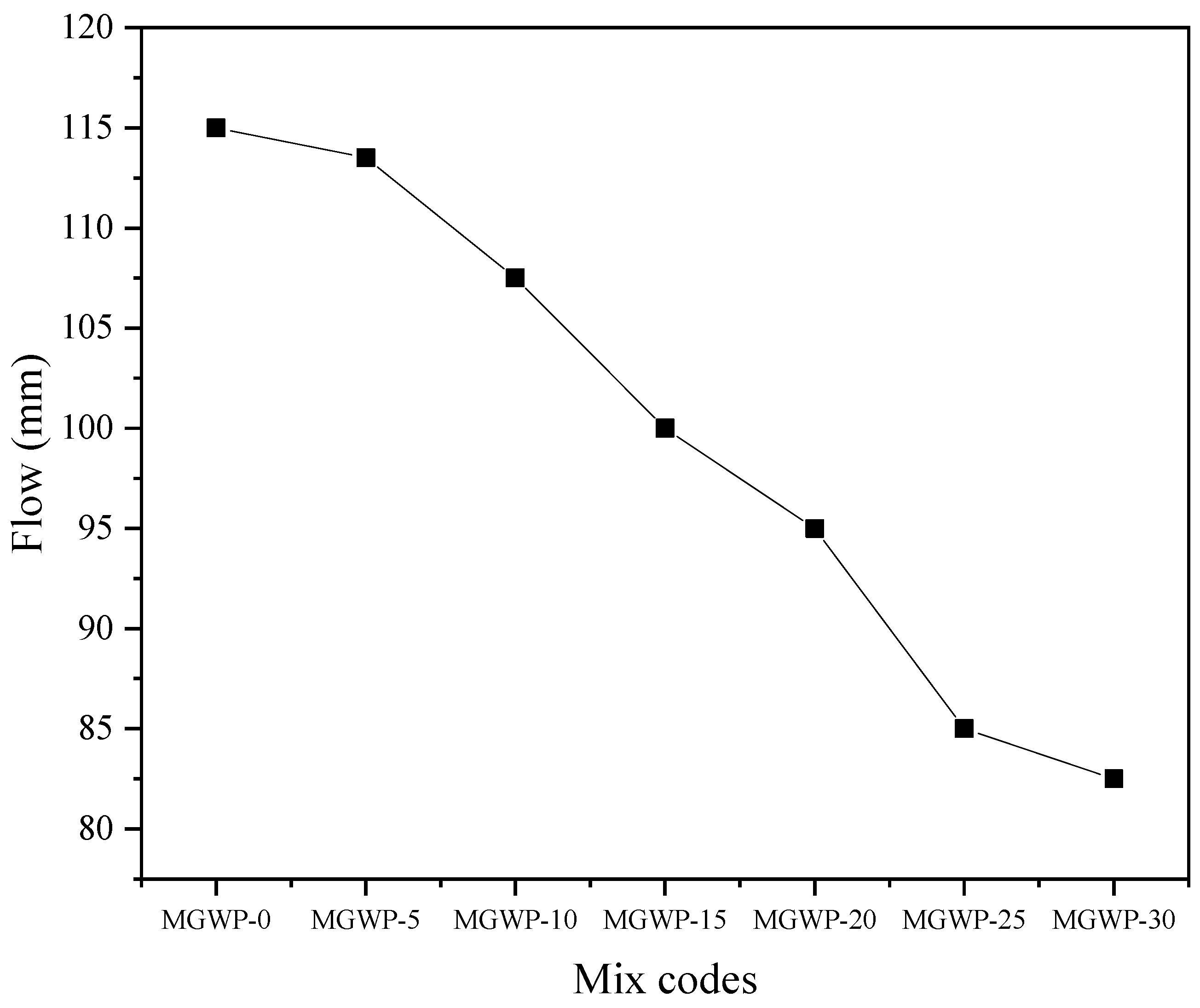

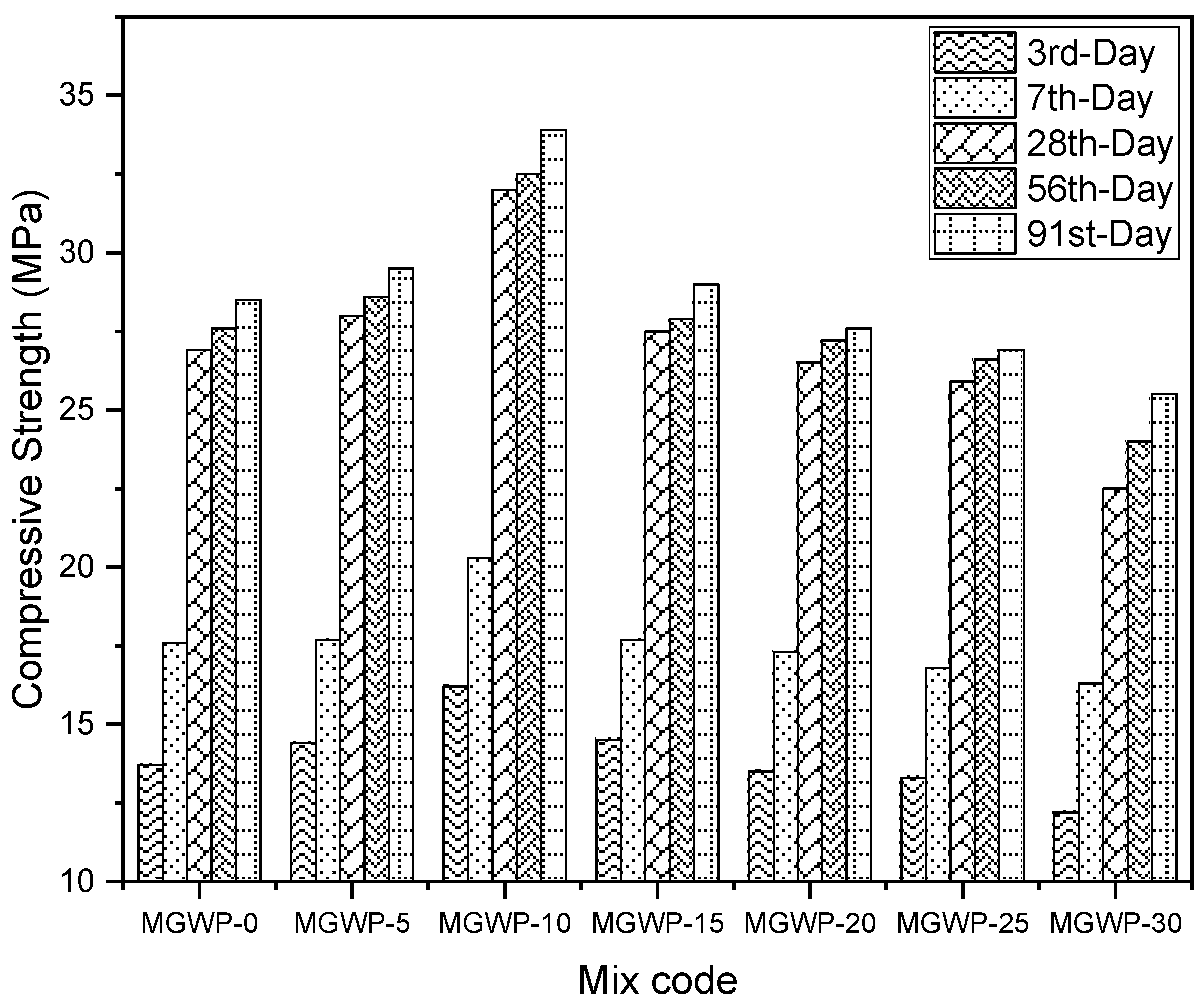
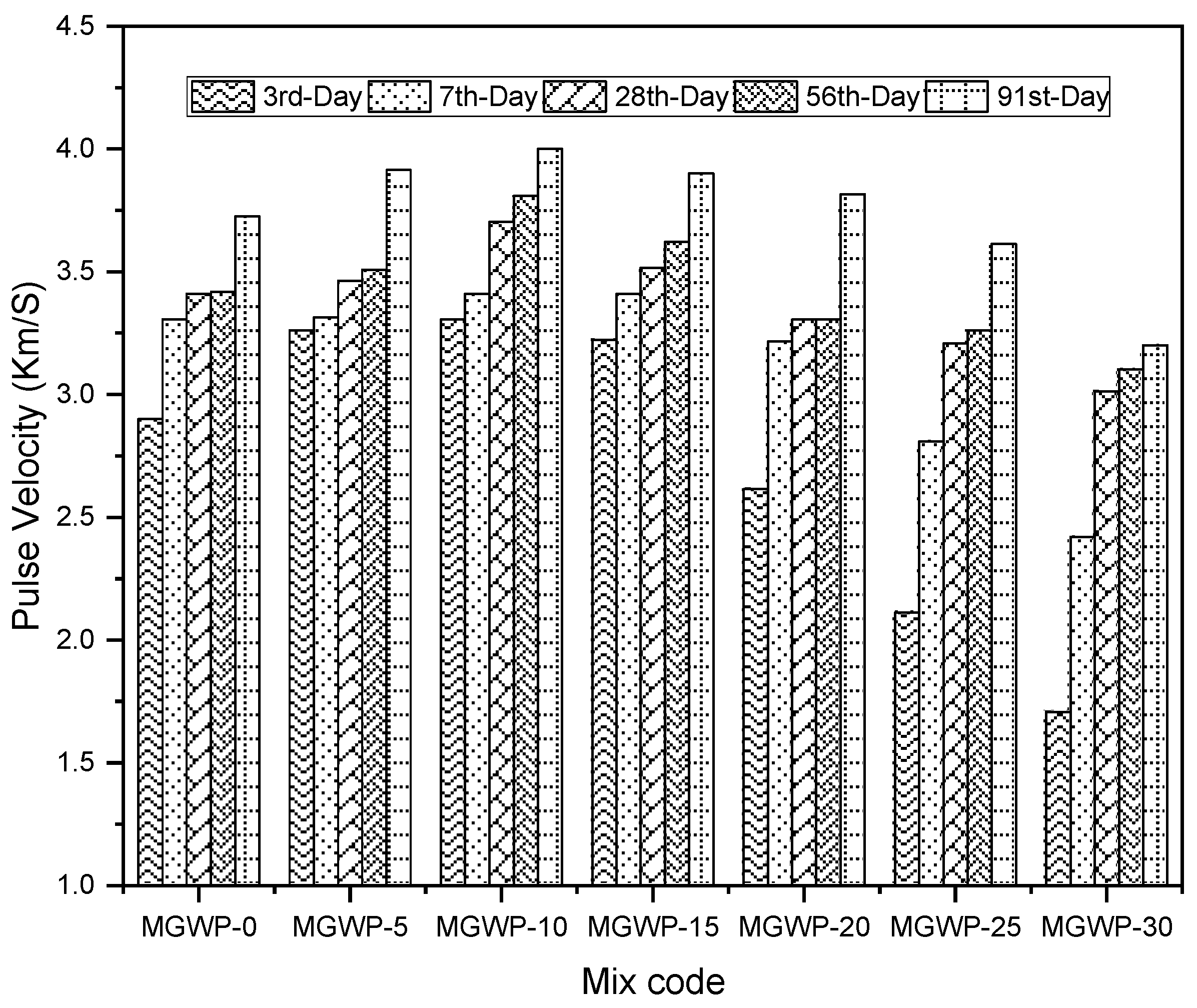
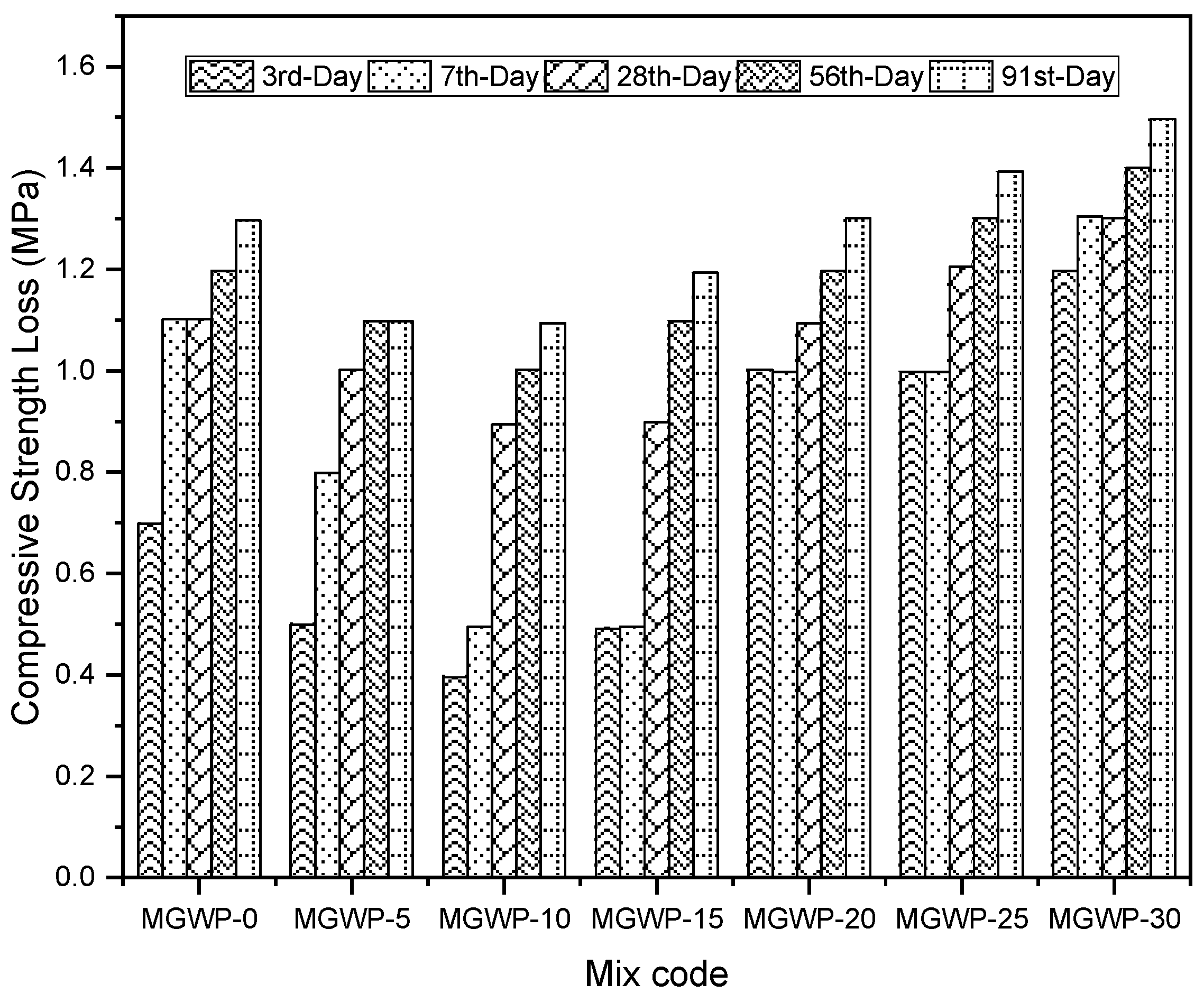


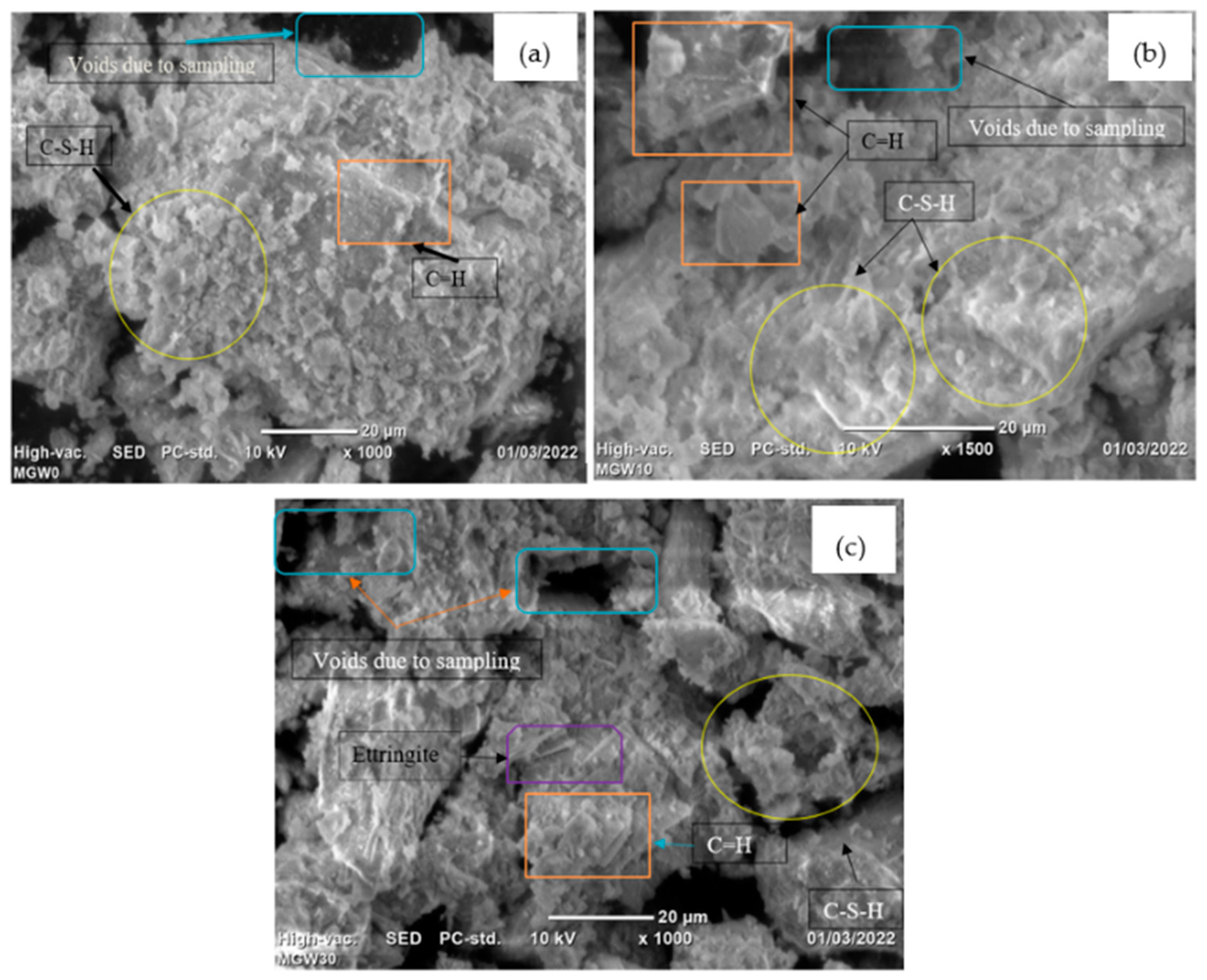

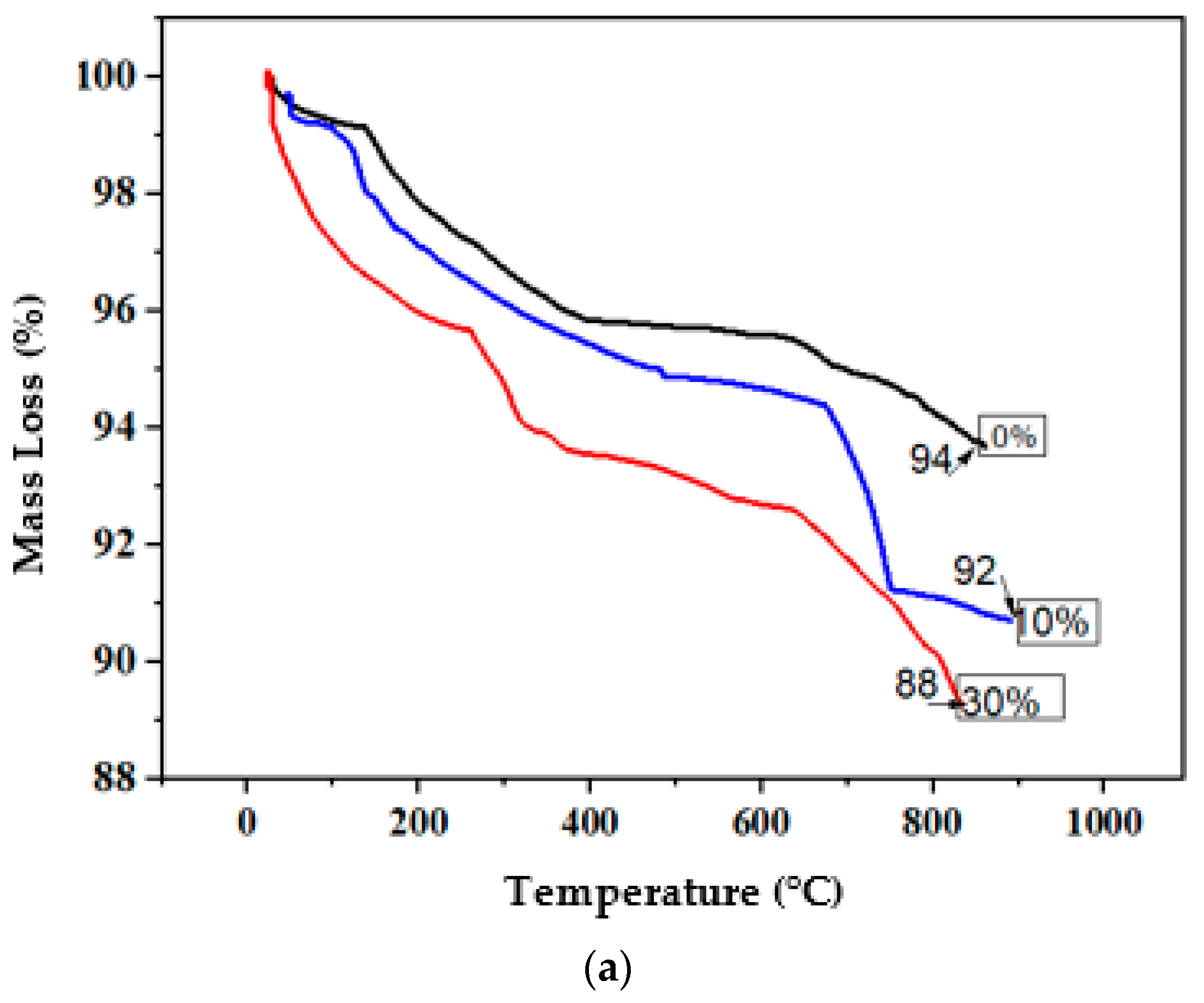
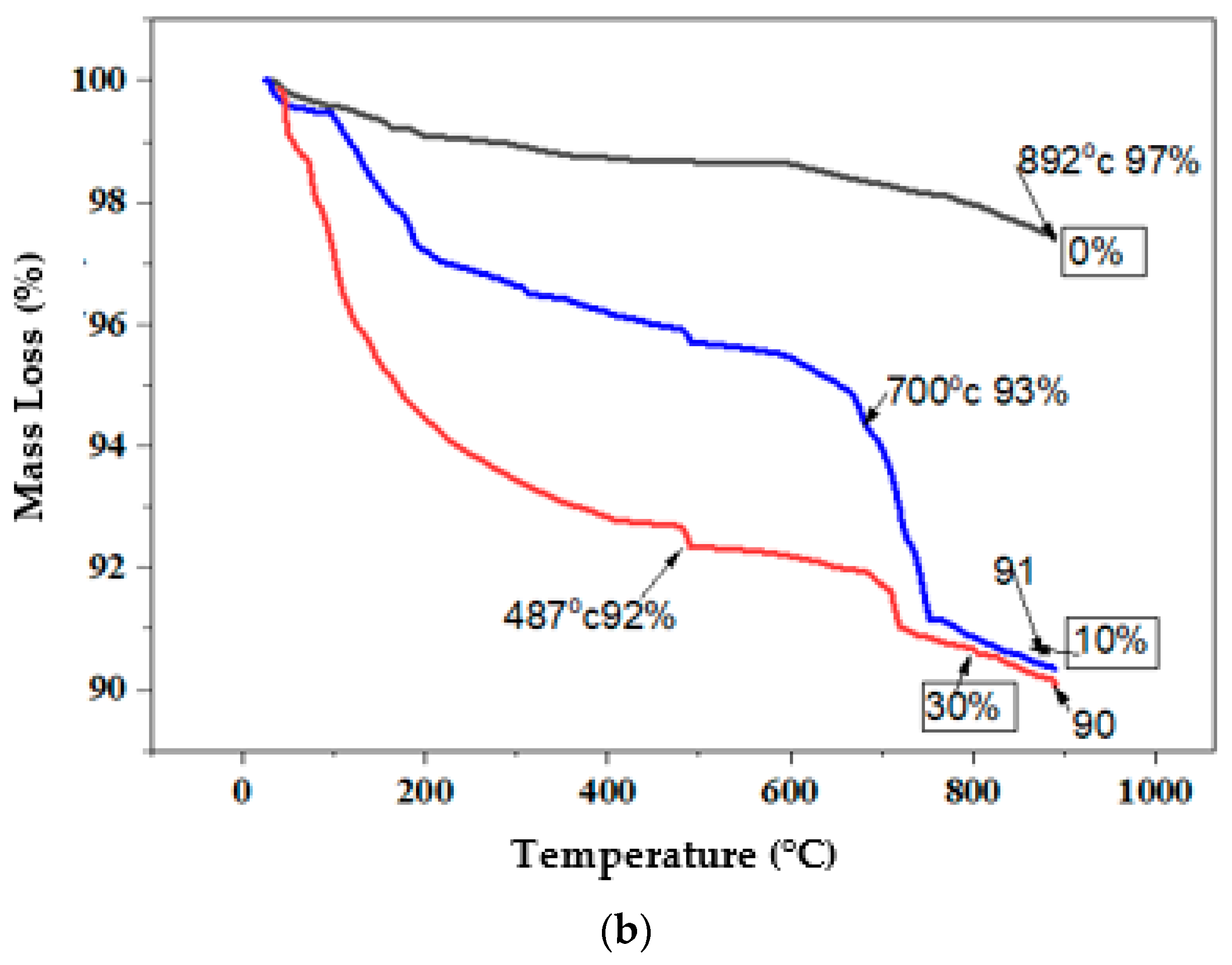
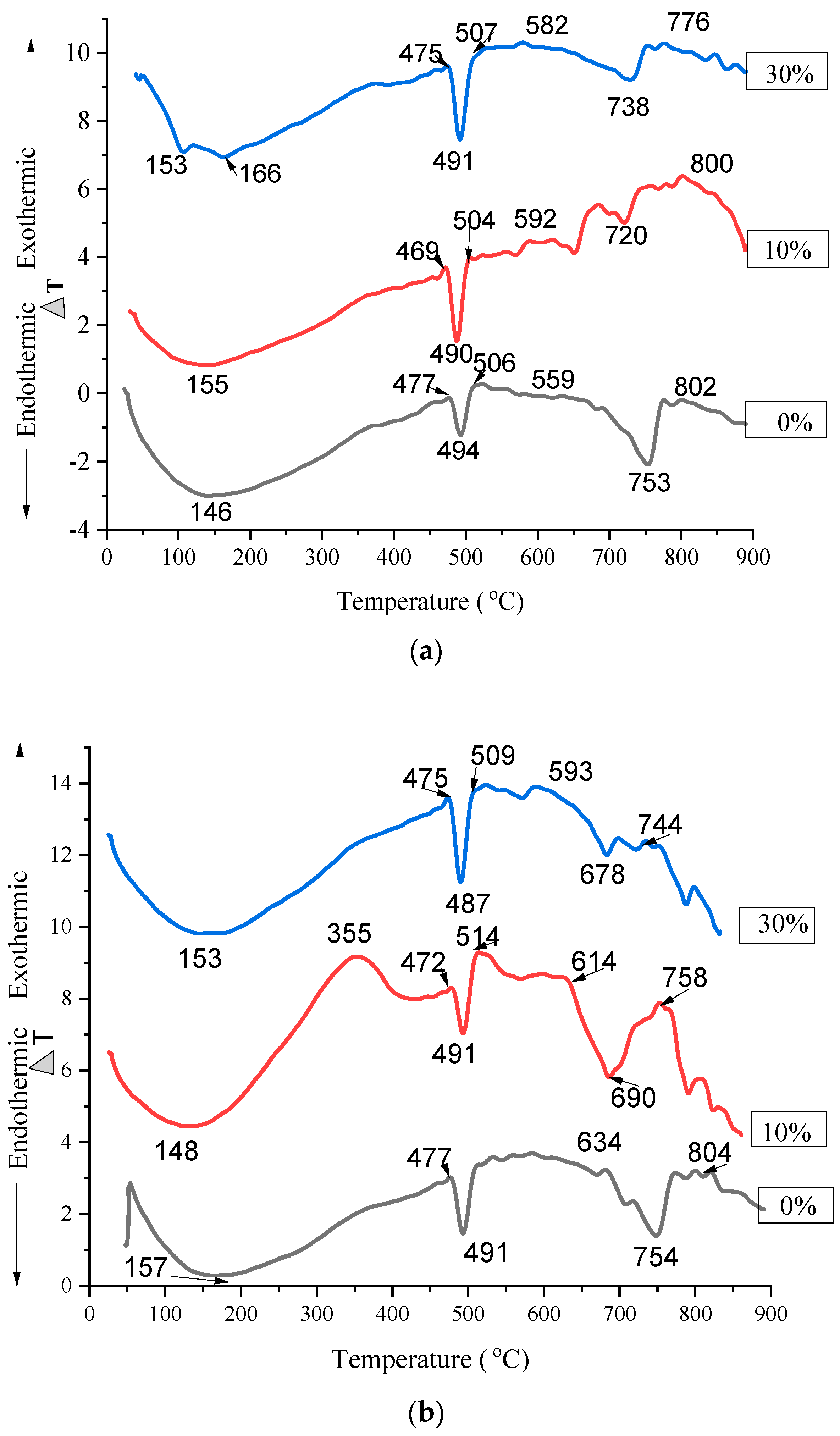
| Properties | OPC | GWP | MWP | |
|---|---|---|---|---|
| Physical properties | Specific surface area | 331 m2/kg | 1635 m2/kg | 1628 m2/kg |
| Color | Dark grey | Grey | White | |
| Chemical properties | Oxides | |||
| CaO | 64.31 | 3.96 | 52.28 | |
| SiO2 | 21.57 | 70.1 | 1.44 | |
| Al2O3 | 5.73 | 14.02 | 0.01 | |
| Fe2O3 | 3.48 | 1.84 | 0.01 | |
| SO3 | 1.2 | – | – | |
| MgO | – | 0.66 | 2.18 | |
| K2O | 1.05 | 3.32 | 0.01 | |
| LOI | 1.5 | 1.72 | 41.59 |
| No | Test | Standard | Result | Unit |
|---|---|---|---|---|
| 1 | Fineness modulus | ASTM C33/C33M [22] | 3.1 | [–] |
| 2 | Specific gravity | ASTM C128 [23] | 2.74 | [–] |
| 3 | Water absorption | ASTM C128 [23] | 3.09 | [%] |
| 4 | Free moisture content | ASTM C566 [24] | 2.1 | [%] |
| 5 | Loose bulk density | ASTM C29/C29M [25] | 1686.33 | [kg/m3] |
| 6 | Compacted bulk density | ASTM C29/C29M [25] | 1870.5 | [kg/m3] |
| 7 | Voids | ASTM C29/C29M [25] | 2 | [%] |
| 8 | Silt content | ASTM C136 [21] | 1.67 | [%] |
| No. | Mix Code | Cement [%] | Marble [%] | Granite [%] |
|---|---|---|---|---|
| 1 | MGWP-0 | 100 | 0 | 0 |
| 2 | MGWP-5 | 95 | 2.5 | 2.5 |
| 3 | MGWP-10 | 90 | 5 | 5 |
| 4 | MGWP-15 | 85 | 7.5 | 7.5 |
| 5 | MGWP-20 | 80 | 10 | 10 |
| 6 | MGWP-25 | 75 | 12.5 | 12.5 |
| 7 | MGWP-30 | 70 | 15 | 15 |
Disclaimer/Publisher’s Note: The statements, opinions and data contained in all publications are solely those of the individual author(s) and contributor(s) and not of MDPI and/or the editor(s). MDPI and/or the editor(s) disclaim responsibility for any injury to people or property resulting from any ideas, methods, instructions or products referred to in the content. |
© 2023 by the authors. Licensee MDPI, Basel, Switzerland. This article is an open access article distributed under the terms and conditions of the Creative Commons Attribution (CC BY) license (https://creativecommons.org/licenses/by/4.0/).
Share and Cite
Nega, D.M.; Yifru, B.W.; Taffese, W.Z.; Ayele, Y.K.; Yehualaw, M.D. Impact of Partial Replacement of Cement with a Blend of Marble and Granite Waste Powder on Mortar. Appl. Sci. 2023, 13, 8998. https://doi.org/10.3390/app13158998
Nega DM, Yifru BW, Taffese WZ, Ayele YK, Yehualaw MD. Impact of Partial Replacement of Cement with a Blend of Marble and Granite Waste Powder on Mortar. Applied Sciences. 2023; 13(15):8998. https://doi.org/10.3390/app13158998
Chicago/Turabian StyleNega, Daniel Mulat, Begashaw Worku Yifru, Woubishet Zewdu Taffese, Yalew Kassa Ayele, and Mitiku Damtie Yehualaw. 2023. "Impact of Partial Replacement of Cement with a Blend of Marble and Granite Waste Powder on Mortar" Applied Sciences 13, no. 15: 8998. https://doi.org/10.3390/app13158998
APA StyleNega, D. M., Yifru, B. W., Taffese, W. Z., Ayele, Y. K., & Yehualaw, M. D. (2023). Impact of Partial Replacement of Cement with a Blend of Marble and Granite Waste Powder on Mortar. Applied Sciences, 13(15), 8998. https://doi.org/10.3390/app13158998






